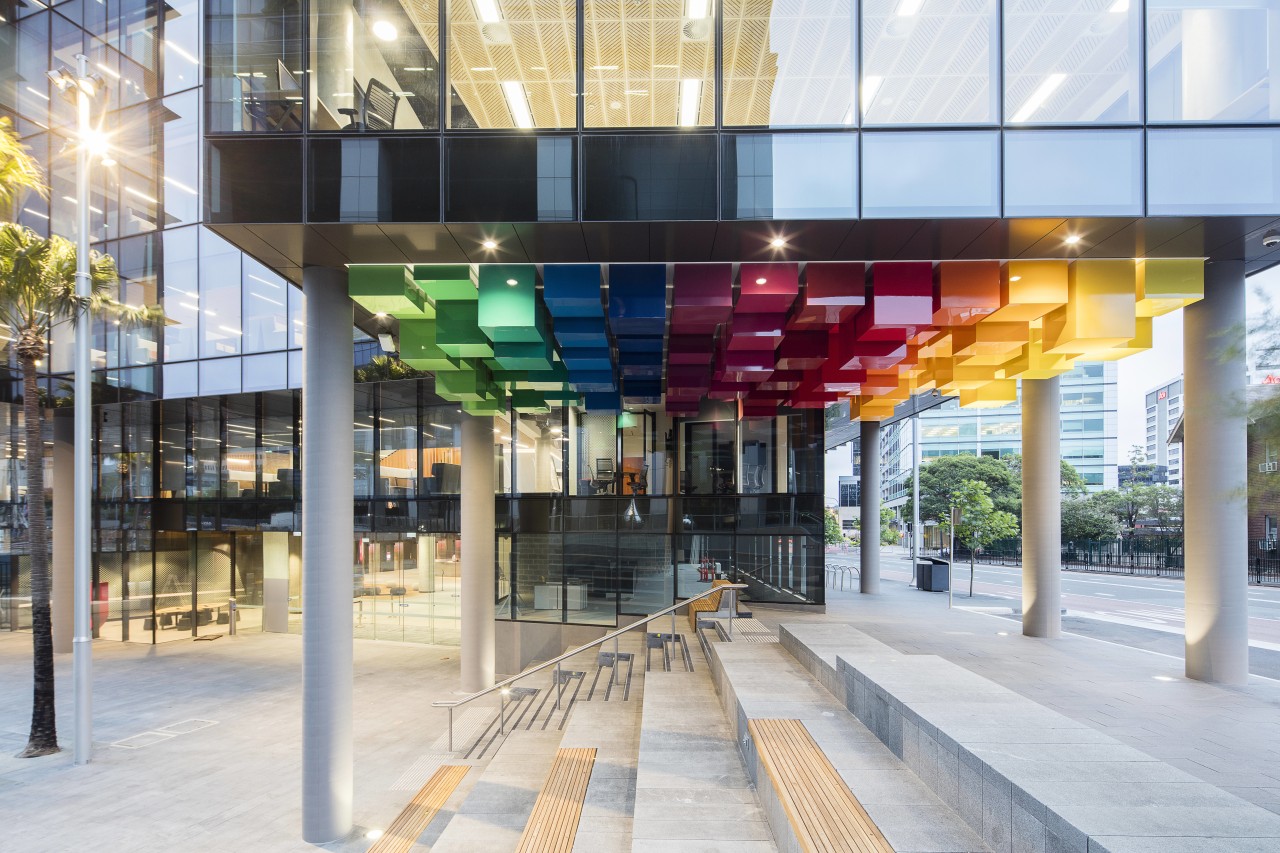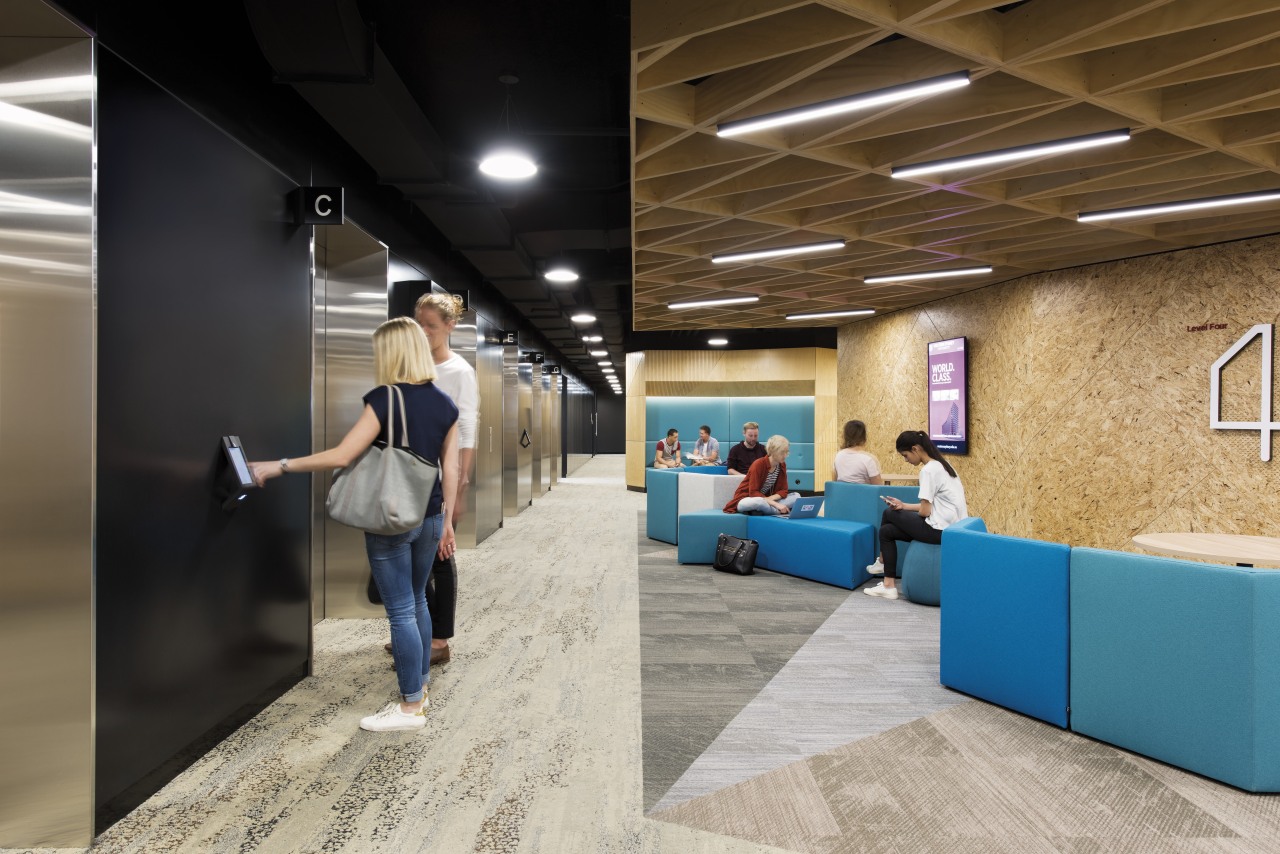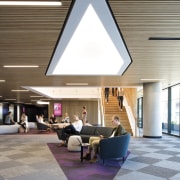A-Grade office building now includes university campus as well as commercial tenants
Quality open-plan office floors translate seamlessly into open-plan, egalitarian learning spaces in the modern vertical campus for Western Sydney University at 1 Parramatta Square

Contemporary office buildings offer open-plan floors and plenty of natural light attributes that it turns out are also well-suited to other uses than business. 1 Parramatta Square is a good example. Initially, designed as commercial office space, the building's broad, open floorplates, large atrium, and light-filled interiors proved equally ideal for a quite different kind of tenant it is now home to the Western Sydney University (WSU) vertical campus with its dramatic new style of learning environments.
Architectus won a competition to design the podium and tower when it was first conceived as an 15-storey A-Grade office building, says project architect Colin Odbert. However, events overtook and developer Charter Hall leased the nine-level podium of the proposed building to Western Sydney University as a new vertical campus.
"The reason the existing design was pursued and tweaked to accommodate the campus was because at the end of the university's 15-year lease it can potentially be returned back to commercial office space. If we had designed a university campus afresh on this prime site, it would not have been suitable for later occupation by business tenants."

The shape of the tower and podium structure is very much a response to its environment.
"The triangular podium maximises site coverage and the tower cranks back to the west to sit below the sun access plane, avoiding shading the heritage-listed Lancer Barracks to the south east," says Odbert. "The building form also responds to the oblique geometry of the Smith and Macquarie Street intersection."
The services core is clad in a light terracotta rain screen that evokes the sandstone prevalent in many of Parramatta's historic buildings. The core is located on the west of the building shielding the building from the harsh western sun. This allowed for a highly transparent fae§ade, without relying on excessive external shading, and limited the energy required to keep the interiors of the building cool."
While the exterior retains the look of a modern office building, on the inside several aspects of the design were tweaked to accommodate the campus.

"However, given the advanced style of learning environments proposed for the building, these changes were not radical more services-driven than structural," says the architect.
"The large light-filled atrium was ideal for a sense of connection across levels and the expansive, uninterrupted floor plates 2145m² at podium level were already ideal for the kind of learning-without-classrooms philosophy behind the campus."
One major change from office floors to campus was the density of occupancy, growing from around 1 person to 10m² to one person to every 8m².
To cope with the higher occupancy, Architectus addressed four principal elements. An additional escalator and lift were added to the design, mechanical services were upped to keep the building cool despite the increased numbers, bathroom capacity was increased and, lastly, the fire stairs were widened to cope with increased numbers.
"What is more surprising is not these changes to the design, but rather the relatively minor adjustments necessary for change from lucrative office spaces to campus and the potential to revert back, at a later date."
Woods Bagot undertook the interior design of the contemporary campus. Director Georgia Singleton said the company took an agnostic approach to the fit-out, allowing for a truly flexible, multidisciplinary and future-proofed learning environment.
"There are no lecture theatres within the space, instead the design fosters an interactive approach to teaching and learning a prominent aspect of the WSU curriculum," says Singleton. "One objective was to create an agile educational environment that enables adaptation to almost any university group."

A vertical campus stacked over several floors could potentially inhibit opportunities for students and educators to commingle and interact. With 1 Parramatta Square, however, the atrium creates a ready sense of community and connectivity.
"The interconnecting stairs and voids encourage collaboration and organic conversation between students and staff," says the designer.
On the podium floors, circulation runs around the perimeter of the floorplate with grouped learning spaces resembling classrooms in the middle. However, there is no front or back, or even walls students intermingle with lecturers in an egalitarian environment that fosters interaction and banishes the old back-of-class boredom. There are also enclosed quiet/study spaces on all podium floors.
Besides the radical, open layouts, cutting edge technology permeates every aspect of the campus, with students able to book a time remotely to, say, pick up student ID cards or get advice. Information stands throughout the building display real-time public transport information and the classes on at that time, and the rooms in which they are located.
The podium finishes on level 8 and includes a rooftop terrace alongside the tower. Levels 8 to 10 include workspaces for staff and conference and function spaces, while commercial clients occupy the top floors. 1 Parramatta Square provides a forward-looking combination of a 5 Green Star university campus and commercial tenants, all at one high-profile address.
Credit list
Project
Architects
Construction
Structural/civil engineer
Acoustic
Landscaping
Cladding
Facade
Hardware
Public flooring
Ceiling
Heating/air conditioning
Bicycle racks
CCTV
Lift and escalator services
Public art artist
Developer
Interior design
Town planner
Quantity surveyor
DDA and BCA consultants
Traffic engineer
Roof
Glazing system
Balustrades
Paints
Lighting
Public area furniture
Security
Signage
Public art
Story by: Charles Moxham
Home kitchen bathroom commercial design
Classic looks, contemporary efficiency
Diving into nature
Personality plus
Commercial Design Trends Vol. 33/3C
The retail sector is in the midst of massive disruption as online shopping takes an ever increasing slice of the consume...
Read More












